Risk of Being Killed by Police Varies by Your Ethnicity
A Healthcare Issue
Derek Chauvin trial live: Paramedic who responded to George Floyd told partner.
‘I think he’s dead.’
When paramedics arrived, Bravinder saw multiple officers on the side of the road on top of “our patient lying on the ground next to a squad car. He said he
“assumed there was potentially some struggle still since they were still on top of him.”
“Prosecutor Erin Eldridge played a clip of officer Thomas Lane’s body camera video, which shows Floyd lying handcuffed, flat on the ground, on his stomach and unmoving as the paramedics bring over a stretcher.
Bravinder is seen making a gesture with his hand, indicating that Chauvin needs to move his knee so that Floyd can be put on the gurney. Bravinder also tries to ensure Floyd’s head doesn’t slam into the ground while he’s moved because his body is limp, according to the video.”
You can only kill or murder a person once. Anything afterwards is a lack of respect for the humanity.
The link will take you to the article from which these snippets are taken from and leading off this post. What I wish to do today is post on the risk of confrontations and the resulting impact with the police. In most cases, a conversation with a police officer is a matter of intimidation.
“Risk of being killed by police use of force in the United States by age, race–ethnicity, and sex”
Being a numbers oriented person, I approach detail in a different manner. There are writers at AB who are far more nuanced (?) than I am. I am direct and I follow the numbers.
Whether cause related or not, police violence is a leading cause of death for young men in the United States. Over a life time, an approximate “1 in every 1,000″black men will (or can expect to) die from police intervention. “
Risk
The risk of dying from police intervention peaks between the ages of 20 and 35 years of age for men and women. This includes racial and ethnic groups. Separate from Black women and men, Latino men, American Indians, and Alaska Natives are more likely to die from police intervention than white women and men.
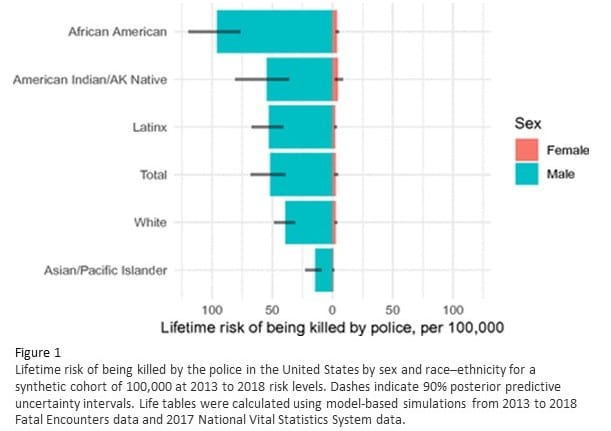
Race and Gender
Fig. 2 displays the ratio of lifetime risk for each racial – ethnic group relative to risk for whites for both men and women. For example; black men are ~ 2.5 times more likely to die from police intervention over their life time than white men. The danger for black women is less; however it still exceeds that of white women by ~ 1.4 times.
The risk varies for different racial groups in comparison to White Americans being 1. Asians and Pacific Islanders are less likely than White Americans to die from police intervention.
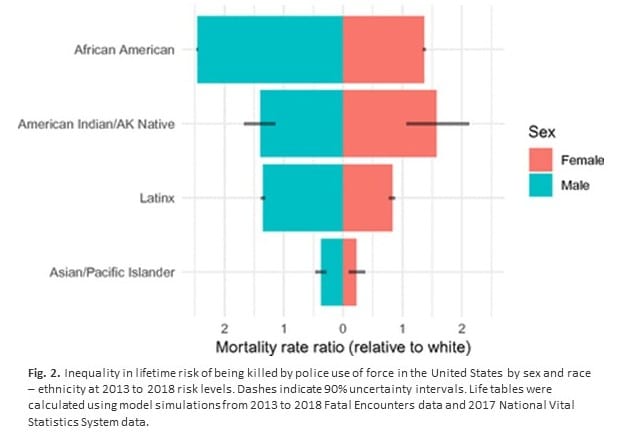
Amongst all groups, black men and boys have the highest lifetime risk of being killed by police. As presented; Proceedings by the National Academy of Sciences, their models predict about 1 in 1,000 black men and boys will be killed by police over the life course (96 [77, 120] per 100,000).
In contrast? A women’s lifetime risk of being killed by police is about 20 times lower than men’s risk. Among women and girls, a black women and American Indian/Alaska Native women’s risk is the highest. An expectation between 2.4 and 5.4 black women and girls will be killed by police over the life course per 100,000 at current rates.
Male – Age Related
Fig. 3 displays male age-specific rates of death by police “use of force” as displayed by race–ethnicity. Risk for all groups peaks between the ages of 20 and 35 years and declines with age.
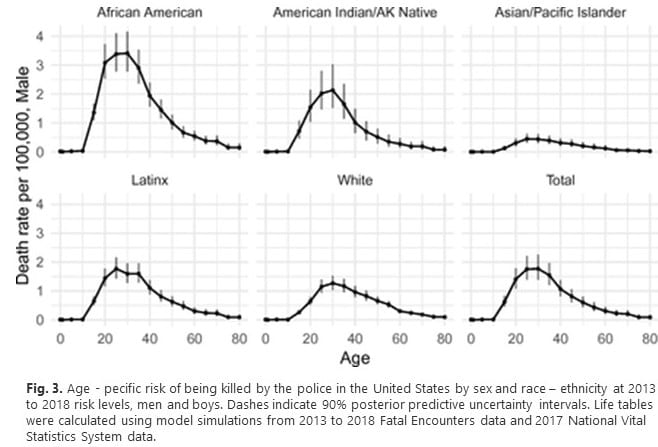
Female – Age Related
Fig 4. Female gender, age, race – ethnicity, and age related rates of death occurring from police intervention. Risk for all groups also peaks between the ages of 20 and 35 years and declines with age.
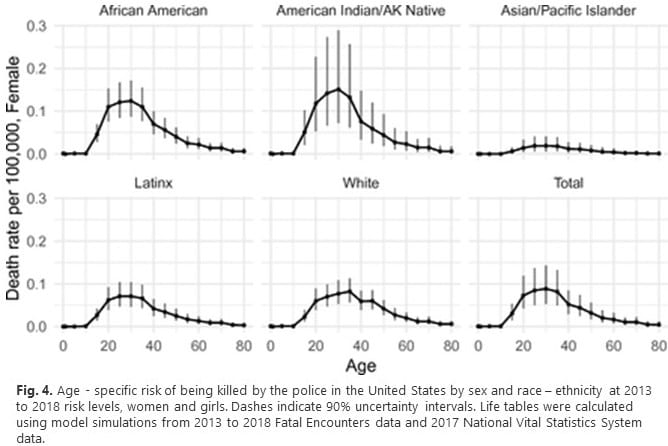
Age, Sex, and Race
Fig. 5 displays the ratio of police use-of-force deaths to all deaths by age, sex, and race.
In the United States, the use of force by police accounts for 0.05% of male deaths, and 0.003% of female deaths, and a low overall share.
The ratio correlates with age and race and is unequal across racial groups.
Police use of force is responsible for 1.6% of all deaths involving black men between the ages of 20 and 24 years. At the same age range, police are responsible for 1.2% of American Indian/Alaska Native male deaths, 0.5% of Asian/Pacific Islander male deaths, 1.2% of Latino male deaths, and 0.5% of white male deaths.
For women between the ages of 20 and 24 years, the police use of force is responsible for 0.2% of all deaths of black women, 0.2% of all deaths of American Indian/Alaska Native women, 0.05% of all deaths of Asian/Pacific Islander women, 0.16% of all deaths of Latina women, and 0.11% of all deaths of white women.
Women of color suffer more than white women at the hands of police. To wit, males and black males especially suffer more (in comparison) at the hands of police within an interaction.
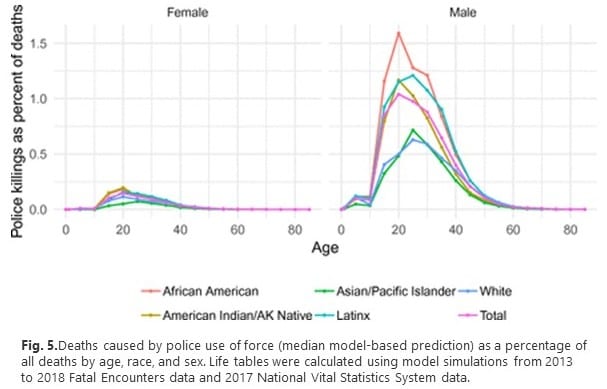
Conclusion:
This presentation concludes what many of us perhaps already know.
Black people remain disproportionately more likely than white people to be killed by police. However, the share of white deaths has also been increasing in recent years.
This particular analysis depicts the risk of dying from police intervention as associated with one’s race, gender, and age. Various races and ages face a higher risk of death or injury when confronted by police intervention. In conclusion, a police intervention is a leading cause of death for young men, and in particular young men of color.
I am over stating the conclusions reached by this particular paper. Young men face exceptionally high risk of dying from police intervention. Racial risk inequalities are increasing throughout the life course. This study reinforces calls to treat police violence as a public health issue. Racially unequal exposure and in general, the risk of state supported violence has consequences for public health, democracy, and racial stratification.
It is only worsening.

This is a video of VA Police being asses and making a fool of themselves because …
https://abcnews.go.com/US/wireStory/lawsuit-virginia-police-officers-threatened-man-stop-76982103
Does bring back a memory of when we first went into drydock in Newport News in the fall of 1964.
Ken:
I saw tis one. You did exactly what I was going to do with it. You posted it as a comment which adds to the main theme.
Mo betta link for the video
https://www.pilotonline.com/news/crime/vp-nw-windsor-police-20210408-a4ynzlmqpjgq3a755hlgpk4qqe-story.html
I read this article with high hopes. Sadly, my hopes were dashed by an intellectually dishonest use of statistics.
The article opens by claiming blacks have about 2.5 times the risk of dying at the hands of the police over their lifetimes as whites. It then quantifies this lifetime risk of dying from police violence for blacks as 1 in 1000. It provides no context for understanding these numbers.
Here is some context. The table below shows the lifetime odds of death from various causes based on 2019 National Safety Council data.
(https://injuryfacts.nsc.org/all-injuries/preventable-death-overview/odds-of-dying/)
Heart disease 1 in 6
Cancer 1 in 7
All preventable causes of death 1 in 24
Chronic lower respiratory disease 1 in 27
Suicide 1 in 88
Opioid overdose 1 in 92
Falls 1 in 106
Motor-vehicle crash 1 in 107
Gun assault 1 in 289
Pedestrian incident 1 in 543
Motorcyclist 1 in 899
Drowning 1 in 1,128
Apparently a black’s lifetime risk of dying at the hands of the police is close to anyone’s risk from drowning, and about a tenth as great as dying in a motor vehicle crash. Very few people obsess over those risks—why the media frenzy about dying at the hands of the police?
By far the most significant finding from the author’s analysis is that far more men die at the hands of the police than do women across all races. (“A women’s lifetime risk of being killed by police is about 20 times lower than men’s risk.”) The difference between male and female outcomes is an order of magnitude greater than the largest difference in outcomes among men of different races, or among women of different races.
It is intellectually dishonest to focus attention on racial disparities when obvious sexual disparities dominate the statistics.
It also seems odd to discuss racial disparities in women’s overall lifetime risk of dying from police violence, when a black woman’s risk is only about 1 in 20,000 in the first place. For perspective, the National Safety Council reported that 1 in 2,535 people will die of choking on food, and 1 in 8,248 will die from sunstroke. It seems that a back woman’s chance of dying at the hands of the police is much lower than the media suggests.
Unfortunately the author chose to show death rates per 100,000 from police encounters without providing a contextual comparison with other causes of death. How do these death rates compare to well-known public health problems like heart diseases, cancer, or opiate overdose deaths for example?
Here is some context from a 2017 National Vital Statistics Report:
https://www.cdc.gov/nchs/data/nvsr/nvsr68/nvsr68_06-508.pdf
All races and origins, both sexes, 20–24 years Death Rate/100,000
… All causes . . . . . . . . . . . . . . . . . . . . . . . . . . . . . . . . . 95.6
1 Accidents (unintentional injuries) . . . . . . . . . . . . . . . 42.9
2 Intentional self-harm (suicide) . . . . . . . . . . . . . 17.0
3 Assault (homicide) . . . . . . . . . . . . . . . . . . . . . . 13.9
4 Malignant neoplasms . . . . . . . . . . . . . . . . . . . . 3.7
5 Diseases of heart . . . . . . . . . . . . . . . . . . . . . . . 2.7
All other causes . . . . . . . . . . . . . . . . . . . .(residual) 12.0
The author’s reported death rate from police violence of 3 per 100,000 among 20-year-old blacks is lower than the overall rate of death from suicide, homicide, cancer, and heart disease at the same age. Are the 3.5 deaths per 100,000 among 30-year-old blacks more unusual?
All races and origins, both sexes, 25–34 years Death Rate per 100,000
… All causes . . . . . . . . . . . . . . . . . . . . . . . . . . . . . . . .132.8
1 Accidents (unintentional injuries) . . . . . . . . . . . . . . 56.6
2 Intentional self-harm (suicide) . . . . . . . . . . . . . . . . . 17.5
3 Assault (homicide) . . . . . . . . . . . . . . . . . . . . . . . . . . 12.1
4 Diseases of heart . . . . . . . . . . . . . . . . . . . . . . . . . . . 8.1
5 Malignant neoplasms . . . . . . . . . . . . . . . . . . . . . . . . 8.0
6 Chronic liver disease and cirrhosis . . . . . . . . . . . . . 2.0
… All other causes . . . . . . . . . . . . . . . . . . .(residual) 23.1
As before, the death rate for everyone from suicide, homicide, cancer, and heart disease greatly exceeds the death rate for blacks from police violence. Note that neither heart disease nor cancer is usually considered a major public health threat to 20-30 year-olds of any ethnicity. Note too that death rates from suicide at ages 20 and 30 surpass death rates from heart disease and cancer, and are six times higher than the author’s stated rate of death from police violence. A rational concern about premature death should probably focus on suicide and assaults rather than police violence.
The author’s conclusion that “Various races and ages face a higher risk of death or injury when confronted by police intervention” is simply not supported by the data presented. That conclusion would require an analysis of death rates per 100,000 encounters with police, rather than death rates per 100,000 people.
Sadly, the author left out any estimate of how many police encounters occur over a lifetime within each segment studied, and how many of those encounters do NOT end in death. This information is crucial for calculating how frequently an encounter with police officers ends in death. If, for example, one group has ten times as many lifetime encounters with the police, it would be reasonable to expect ten times as many deaths in that group. This may well be the situation with men versus women. If the high encounter group had more or less than ten times as many deaths, that would be cause for investigation into possible discrimination.
Obviously if certain ethnic groups have more encounters with the police than others, that difference should be a matter for concern and further investigation. It might be a consequence of some form of racial inequality. However, it helps no one to simply assume that differences in death rates per 100,000 are evidence of racial injustice.
If racial discrimination in policing exists, it seems likely to show up in the frequency or number of lifetime encounters with the police. But even knowing numbers of encounters is not enough to evaluate possible discrimination because the nature of a police encounter influences how much force is likely to be used by the police. For example, someone robbing a gas station or store with a gun seems far more likely to face police violence than a shoplifter. Someone drunk or high on drugs seems more likely to face police violence than a sober person. It seems reasonable to ask whether factors that increase risk during police encounters occur more frequently in certain ethnic groups, and if so why.
The author’s observation about the lower rates of death among Asians and Pacific Islanders is important and warrants serious study. Do people of this ethnicity have fewer encounters with the police? If so, why? Are the encounters of a different kind than black encounters with the police? Do Asians behave differently than blacks when encountering the police? What actual factors lead to the seemingly different results across ethnicities?
Answering these questions with “structural racism” or a something similar provides no actionable way to help improve results for any ethnicity. Calling police violence a health problem also does nothing to improve outcomes.
The author seems to have assumed from the beginning that policing is the problem. As a result he completely ignored at least two important questions:
1. Why do most encounters with the police across all ethnicities NOT end in death?
2. Are there behaviors in these many non-deadly encounters that can be taught to people and police to reduce the chance of police violence?
It seems worth reflecting on these questions and seeking answers to them.
As a final note, it took me less than five minutes to find data to put this author’s statistics in context. I can only wonder why the author did not take the time to do the same.
Neil:
I pulled you out of spam just to get your commentary on site to answer it. Not going to do it now, I am tired and will do so tomorrow.
Parfait!
Neil:
The topic of the post as taken from an article (linked to) is the risk of being killed (or murdered) by police varies according to your ethnicity. It did not include other case of death.
With your conflation of the post’s topic comes many other causes of death not included in the original article. You then make a broad-based assumption the killing (or murder) of Black Americans is acceptable to Americans the same as deaths by automobile accidents, etc. reflecting societal acceptance of the risk of driving an automobile. Since many Americans including Black Americans die from automobile accidents it is ok to conflate the purposeful killing of Black Americans as acceptable as it occurs less.
It is not the same and neither is it acceptable.
Floyd did not give the police a reason to shoot him when they stuck their pistol through the care window which created a quandary for them. His struggle did allow them to take additional action to subdue him, which the police did do. However, his struggle does not include any action causing his purposeful death by Chauvin. Neither did drugs or heart disease cause his death as attorney Eric Nelson would like the jury to believe. A handcuffed man on the ground is no longer a high risk.
Plain and simple, you do not get to murder “your” prisoner by strangling them by kneeing on their neck. Neither was I allowed to beat a prisoner in the head with my Ash night stick whether a Black or White man. To wit, such actions by police with Black Americans appears to happen with greater frequency than with White Americans as well as other ethnicities. The reported numbers appear to point in that direction.
“Apparently a black’s lifetime risk of dying at the hands of the police is close to anyone’s risk from drowning, and about a tenth as great as dying in a motor vehicle crash. Very few people obsess over those risks—why the media frenzy about dying at the hands of the police?”Because taxpayer money is not used to fund people dying of cancer, heart disease, motor vehicle accidents or drowning, but taxpayer money is used to fund the police. I’m not prepared to attack your rhetorical question as “dishonest,” but it certainly appears disingenuous.”The author seems to have assumed from the beginning that policing is the problem. As a result he completely ignored at least two important questions:
1. Why do most encounters with the police across all ethnicities NOT end in death?2. Are there behaviors in these many non-deadly encounters that can be taught to people and police to reduce the chance of police violence? It seems worth reflecting on these questions and seeking answers to them.”It is indeed. And both questions assume that policing *is* the problem. The answers may lead to policing being less of a problem.As a final note, it took me less than five minutes to craft this reply I can only wonder why Neil did not take the time to reflect on these obvious points.
“It is intellectually dishonest to focus attention on racial disparities when obvious sexual disparities dominate the statistics.”
WTF is the purpose of this sentence? It has absolutely zero relevance to the topic.
Without contrasting data of the lifetime risks of being murdered by anyone to compare to risk of being killed by police, then conclusions should be avoided. So far, I have only found an old report from 1997 when young black men were over six times as likely to be murdered by anyone than white men of the same age were to be murdered by anyone.
…and if you believe that taxpayers do not pay for all murders, then you have been safe in that cocoon way too long. Cops, courts, living in fear, and social consequences in every direction radiate from the high murder rates that we have in the US. Defund the police? ROTFLMAO. How will less money make for better law enforcement including better cops? Usually if you want better, then you immediately realize that will cost more, not less.
CIUS 1999 Section V – The Chances of Lifetime Murder Victimization, 1997 (Document Pages 279-290) (fbi.gov)
[Still looking, but if one believes this has been being talked about for a long time and nothing has changed then one might expect not much has changed since 1997. A troubled society obsessed with doing everything cheaper instead of better is not likely to become less troubled over time.]
What Are the Odds of Being Murdered? – DiscoverTheOdds.com
[This article was far better than I had expected, a better than average Internet fluff piece. A excerpted highlight is pasted in below.]
“…Based on the data from the CDC report, deaths due to homicide accounted for less than 1% of all U.S. deaths, with the odds of being murdered in a given year at 1 in 18,989. On the other hand, heart disease, the leading cause of death in the U.S., accounted for 24% of all U.S. deaths, with the odds of dying of heart disease at 1 in 517.
Murder and Place: Location, Communities, and Socioeconomics
The odds of being murdered vary significantly on the basis of location. However, it must be noted that careful analysis of the data reveals that “location” is most appropriately understood as referring not only to geography but also to other ways of defining place, including community type and socioeconomic conditions.
When murder rates are discussed from the perspective of location, people often ask which places—specific regions, states, counties, cities, or areas—have the highest and lowest homicide rates. Detailed data on the numbers of murders occurring annually can be found in the FBI’s Uniform Crime Reports (UCR). Moreover, when cities or communities are grouped together or categorized by community type—rural, suburban or urban—an apparent trend emerges. Rural communities and suburban communities have lower average homicide rates than do urban communities (Schwartz 2010).
Cities, and more broadly, community types, are home to distinctive sets of socioeconomic conditions that form the backdrop of the murders that occur. Socioeconomic context is an important variable to consider when discussing the odds of being murdered. An individual’s socioeconomic context can be defined broadly as the aggregate combination of education, income, and occupation of the people who comprise his or her social sphere. Individuals who are a part of poverty-stricken socioeconomic contexts face greater odds of being murdered while individuals belonging to more affluent socioeconomic contexts have lower odds of being murdered…”
Ron:
Why would you let this slip by?
Here is a good and not necessarily long read if you are interested: “Violence: Reflections on a National Epidemic” by James Gilligan. A long while back, I wrote on the prison population which appears to incarcerate a larger percentage more of Black Americans than White Americans through court proceedings.
The numbers cited are also older. The National Academy of Sciences article appears to be more current.
I can understand why Neil’s comment raised hackles, but referring to a comment that was in moderation as in spam is not a good way to deescalate.
Arne:
The system is automatic for new” commenters. I could have left it in spam or failed to check it. I do check spam and trash as people appear to end up there accidentally and not by intention.
@Run,
It did not slip by me. My purpose of the excerpt was to prompt readers to take the link. The more one excerpts, then the more one needs to excerpt to qualify the prior excerpts. Eventually, I would have had to paste up the entire article on AB. Since it was stuff everyone interested in the subject already knows, then posting the entire thing would have been excessive.
In the case of racial demographics on murder victims it is worth also noting that most whites are killed by whites, most blacks are killed by blacks and most men are killed by men. The exception to that trend being that most women are killed by men too. I wrote this paragraph from memory, either from earlier today or from 50 years ago, I am not sure which.
Note to Neil. Which of those causes of death do we not try to lower? We have spent billions on diseases and had PSA blitzes on all kinds of prevention hotlines from accidental poisonings to suicide.
You can argue with the numbers all you want, but most white people will look at videos of police interaction with Black or other minorities and know that those don’t look the way they expect to or have been treated by police. The fact that even the worst of those interactions are defended by the entire police establishment would have you think they are normal or typical, and the white population of this country knows that really is not the case.